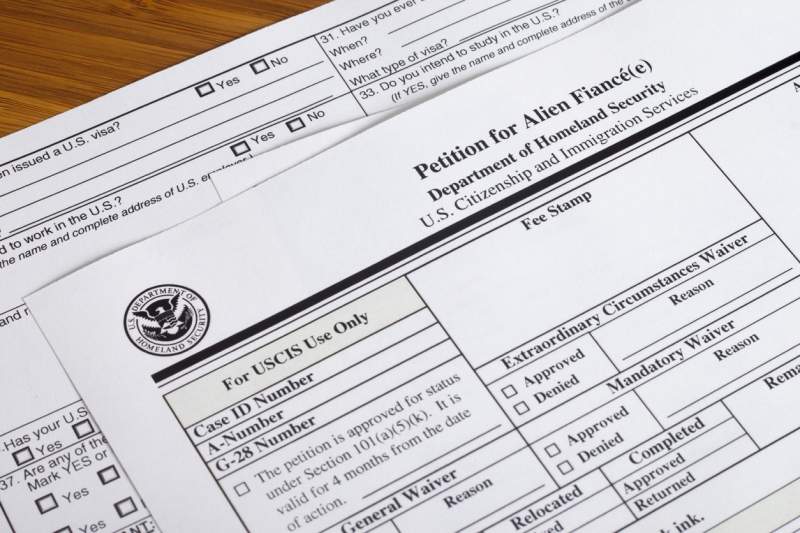Visa
Ultimate Guide To Understanding & Obtaining A K1 Fiancé(e) Visa

The K-1 fiancé(e) visa is a nonimmigrant marriage-based visa for foreign-born U.S. citizens. It allows foreign fiancé(e)s to visit the U.S. to marry their U.S. citizen fiancé(e)s who sponsor their visas.
The K-1 visa allows 90 days for marriage. After that, the foreign fiancé(e) can petition to the USCIS for an adjustment of status to become an LPR and acquire a green card. The K-1 visa allows foreign fiancé(e) dependents to enter the U.S.
Since this visa class is for permanent immigration, applicants must meet immigrant visa standards.
US immigration law defines a fiancé(e) as somebody who receives an accepted I-129F Petition for Alien Fiancé(e). This person should also come to the U.S. to marry the citizen who sponsored and submitted the petition.
Both partners must not be married. Previous marriages must be ended by divorce, annulment, or death for fiancé(e)s to marry in the U.S. upon filing the I-129F petition with the USCIS. The wedding must also follow state legislation.
K-1 Visa Process:
Here are the main steps in the K-1 process:
- The U.S. citizen who is sponsoring the foreign fiancé(e) must submit an I-129F, Petition for Alien Fiancé(e) to the USCIS field office closest to the area where the U.S. citizen lives. It is important to note that the I-129F cannot be submitted to a U.S. embassy, consulate, or overseas USCIS office.
- After the USCIS approves the petition, it is sent to the National Visa Center (NVC) for processing, and the NVC will send it to the U.S. consulate or embassy after assigning it a case number.
- Once the petition from NVC is received by the US embassy or consulate where the foreign-citizen fiancé(e) will be given detailed instructions, including where to go for the needed medical examination. The foreign-citizen fiancé(e) will then be summoned to the consulate for an interview in order to obtain a K-3 visa.
Required Fiancé Visa Documentation:
The K-1 fiancé(e) and all eligible dependents who wish to apply for the K-2 visa will need to bring these items to the K-1 visa interview:
- Online Nonimmigrant Visa Application DS-160. There should be one completed application per K visa applicant.
- A valid passport with a validity period that extends a minimum of six months past the intended duration of stay in the United States. Note: there may be exceptions that are specific to each country, ask your immigration attorney for more information.
The foreign fiancé(e)’s birth certificate - Divorce and/or death certificates from any prior marriages for both the foreign citizen fiancé(e) and the sponsoring U.S. citizen.
- The police certificate from the country in which the foreign-born fiancé(e) currently resides. The police certificates will also be required from any nation in which the foreign fiancé(e) has lived for more than six months since he or she was sixteen years old
- Evidence of an approved medical examination
- Proof of sustainable financial support to evidence that the fiancé(e) will not financially rely on the U.S. economy. (Form I-134, Affidavit of Support, may be requested)
- Two (2) passport-style photos. See these photograph requirements from the Department of State.
- Proof that a valid and non-fraudulent relationship exists between both the U.S. citizen sponsor and the foreign fiancé(e).
- The payment for all accompanying visa fees.
VisaNation can save you the stress and make sure that your application is flawless. This is their fees page
How Much Does a K-1 Visa Cost?
K-1 fiance visa applications have several expenses. The first is the $535 I-129F filing fee. This is paid by the beneficiary’s fiance when filing the petition. If the same U.S. citizen sponsor submits an I-130 Petition of Alien Relative to the USCIS, K-3 applications are free.
The second fiance visa fee is travel to and from the U.S. Consulate or Embassy for your interview. Obviously, this depends on your travel mode and consulate distance.
What Should I Expect At The Interview?
The K-1 visa interview lets immigration agents decide if your connection is a charade to enter the U.S. fraudulently. This may seem daunting, but individuals with a legitimate relationship with their overseas fiancé should not worry.
The officer will ask you straightforward questions about your fiancé(e) and relationship (e.g., where they work, how long you’ve known them). The interview should be quick and you should have a green card soon.
An experienced fiancée visa lawyer can help you prepare for the K-1 visa interview by discussing your position and relationship.
What Happens After Marriage?
Once the marriage has taken place, your new spouse is able to apply for Adjustment of Status in order for him/her to work and live permanently in the country, effectively finishing the K-1 visa process
K-1 and K-2 visa holders may file an application for employment authorization (EAD). It’s important to note that if you file the application prior to filing the Adjustment of Status, then your EAD will expire within the 90-day window (when K-1 expires). For that reason, it’s advised to apply afterward. It’s a hard task to keep track of the requirements, know which forms apply to your situation, and submit your first-ever immigration application.
Getting a Social Security Number
Most individuals are curious about when they get a social security number following marriage. You are able to acquire an SSN after providing an unexpired I-94. You must also have an EAD first before getting an SSN.
Tip: Applying too soon for your SSN could actually result in delays. Wait approximately two weeks after arriving in the country. Otherwise, it may require manual verification from the USCIS because your records of arrival may not be saved in the system yet.
Here’s the process:
Take your marriage certificate with you to the SS office to prove your new married name. If you happen to be making a name change after the marriage is finalized, go to the SS office with your marriage certificate to file for a name change.
What If I Get a K-1 Visa Denial
There are several reasons your K-1 visa may be refused. One of the most common and mundane explanations is erroneous, incomplete, or inconsistent I-129F information. You can fix the mistake and resubmit the petition with a new cost. Before filing, have an immigration attorney analyze your petition to avoid this delay.
If the immigration official at the U.S. Consulate or Embassy doubts your engagement, your visa may be rejected. Unfortunately, if your country has many fraudulent applicants, this can happen.
K-1 Visa To Green Card
Going from a K class visa to a green card is different from other immigrant visa classifications. The LIFE Act allows nonimmigrants from all four K visas to apply for green card status.
This differs from the green card process because K-1 and K-2 holders no longer need the I-130 Petition for Alien Relative. This was done to reduce the time families were separated while waiting for the petition’s priority date. The USCIS advises that if you match the following criteria, you just need to file an I-485 application to convert a K visa to a marriage-based green card.
To be eligible, you must:
- Be a K class visa holder
- Have married your U.S. citizen fiancé(e) within the 90-day window if you are a K-1 holder
- Be eligible to adjust your status
- Have an available immigrant visa number
- Be able to enter the U.S.
The timeframe for adjustment of status varies based on the K visa you have:
- K-1 (foreign fiancé(e)s) holders should adjust their statuses as soon as they marry their U.S. citizen fiancé(e).
- K-2 holders (children of foreign fiancé(e)s) should adjust their statuses at the same time as their K-1 parent.
- K-3 holders (foreign spouses) can adjust their statuses as soon as they enter the U.S.
- K-4 holders (children of foreign spouses) should adjust their statuses at the same time as their K-3 parent.
As a K-1 applicant, you will need to factor the amount of time it will take to get married and receive your marriage certificate before filing the I-485 to adjust your status from a K-1 visa to a green card.
Required Supporting Evidence
To make the adjustment, you will need to submit the following documentation along with your I-485:
- Two photos that adhere to the Department of State’s passport guidelines.
- Your biographical information in a G-325A form.
- A copy of an official photo ID
- A copy of your official birth certificate
- A copy of your passport containing your K class visa
- Your I-94 arrival/departure form
- Your marriage certificate if you have a K-1 visa
- The Affidavit of Support Form I-864
- A copy of any form or application that you used in conjunction with your K class visa.
- A copy of a pending I-130 petition if you are a K-3 or K-4 holder.
- The correct filing fees
K-1 Fiancé(e) Visa Frequently Asked Questions
- Q. What is acceptable proof as evidence of a fiancé(e) relationship?
Things like family and relationship photographs, phone records, letters, cards, etc. During your interview, you will be asked questions that will help the officer verify your relationship. Consult with a K-1 Visa lawyer to determine which other documents may be appropriate.
- Q. Is a K-1 Visa holder able to exit the US?
A K-1 visa holder upon arriving in the US is not allowed to leave and re-enter on the same visa. If you intend to exit the country then re-enter it’s recommended to apply for a travel document with Form I-131 or adjust your status to legal permanent resident.
- Q. Is a K-1 Visa holder allowed to work in the country?
Yes, you can. As we previously mentioned they can once they file Form I-765 for employment authorization and meet the other eligibility requirements.
- Q. Fiance Visa Timeline: How Long Does it Take to Get a Fiancé(e) Visa?
The K-1 visa takes 12-18 months to get, and the green card takes 6-12 months after married in the US. Most processing time depends on the consular office abroad’s backlog. Marriage-based green cards are now processed in 3-4 months in the U.S., compared to 6-10 months. The I-129F alone takes 12 months to approve. Premium processing is not offered for K-1 visa petitions.
I-129F, Petition for Alien Fiancé(e) processing times by field office [as of July 2023]:
– California Service Center: 80% of cases are completed within 16.5 months
-Nebraska Service Center: 80% of cases are completed within 4.5 months
-Potomac Service Center: 80% of cases are completed within 19 months
-Texas Service Center: 80% of cases are completed within 16.5 months
-Vermont Service Center: 80% of cases are completed within 10.5 months
This processing time is based on how long it took USCIS during the last six months to finish 80% of adjudicated cases. Please keep in mind that these are not guarantees of processing times and may take longer or shorter depending on the circumstances.
-I-129F: About 10.5-19 months
-DOS Processing: 4 to 6 weeks after USCIS approval
-Letter From Embassy or Consulate: Approx 2-4 months
-K-1 Visa Interview: 1-3 months
-Inspection at a Port of Entry: Within 6 months after visa approval
-Marriage: Within 90 days after arrival
- Q. What is the K-1 Visa Processing time?
Since the case details determine the time span, there is no exact response. How busy the USCIS service center is affects how long your I-129F petition is processed. The interview in the U.S. consulate or embassy is similar.
However, your green card will likely be processed quickly. Most green card applicants must wait until their priority date (the date the USCIS received their immigrant petition) matches the final action dates provided in a monthly visa bulletin by the Department of State.
As indicated, K-1 and K-2 visa holders do not need an I-130 petition filed on their behalf and only need to wait for the I-485 to be completed, which can take six months depending on the service center’s caseload.
A K-1 visa lawyer can help you estimate the overall time needed to complete the K-1 process.
K-1 visa process should take 12–18 months in 2023 (including USCIS processing Form I-129F). The location of your service center determines waiting times. Additionally, the National Visa Center sends instructions in three to four weeks. This indicates the process may take more than 18 months if you have no application errors that could delay processing.
To check the most up-to-date I-129F processing time, visit the USCIS processing time website.
- Q. Is there a limit on the number of filing petitions?
Two or more K-1 visa filings in your past may require you to apply for a waiver. Also, if you’ve had an approved K-1 petition within the last two years, the same applies.
- Q. Do I need a medical examination to adjust my status?
According to the USCIS, you will not need to obtain a medical examination provided that:
- You already obtained one for your K-1 visa
- The I-485 was filed within one year of that exam
- You did not have a Class A condition when you were examined, or
- You obtained a waiver of inadmissibility for your Class A condition.
Q. What are the consequence of marriage fraud?
Those who commit marriage fraud face harsh penalties, including five years in prison, large fines, or both. At the very least, you will have marks on your immigration record that may make it difficult for you to seek for a visa or green card in the future. The basic thing is that you must ensure that your argument is legitimate.






















